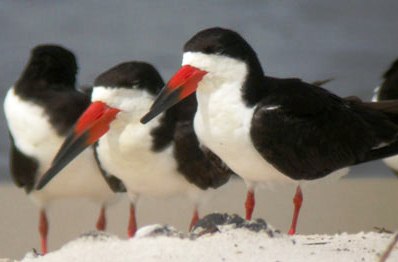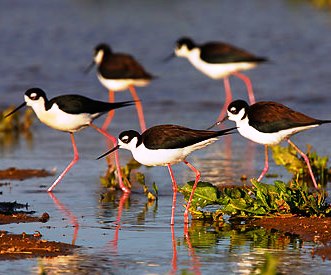Shorebirds
Shorebirds are a common sight in Floridian nature. Black skimmers “skim” the surface of the water with
black-tipped bright red bills. The lower half of the bill is longer than
the upper, allowing it to cut through the water and dip down to grab
small fish encountered near the surface. Adult plumage is black above,
white below and this striking combination, coupled with the brightly
colored bill, makes it easy to spot the birds as they hunt over the
water or loaf on the beach with other seabirds and shorebirds. Black
skimmers, and least, royal and sandwich terns nest in colonies in the
open sand on beaches, sandbars, and dredge material islands. Their nests
are built on the ground and often consist of simple scrapes in the sand.
(Due to habitat loss, a very small percentage of black skimmers also
nest on gravel roofs!) Black skimmers rely on camouflage or group
mobbing to protect their nests. Breeding colonies of black skimmers can
be found along Florida’s Gulf and Atlantic coasts. Watch for them in the
early evening when they actively feed, and scan flocks of loafing birds
for this uncommon coastal resident.
With its black and white plumage, long, thin red legs, and long neck, the Black-necked Stilt is both striking and delicate in appearance. It is a medium-sized shorebird with a black needle-like bill, black or dark brown upperparts, and a white breast. The iris is red, and there is a white spot above the eye. Breeding males have glossy black wings, back, and back of neck, and a pink tinge on the breast. Non-breeding males lack the glossiness and pink tinge. Adult females have a brown tinge to the back. Juveniles have brown upperparts with buff feather margins, and a white trailing edge to the wing in flight. Five species of rather similar-looking stilts are recognized in the genus Himantopus. They have the second-longest legs in proportion to their bodies of any bird, exceeded only by flamingos. This bird's habitat includes salt ponds, rice fields, shallow lagoons, and mangrove swamps. Black-necked Stilts most often consume aquatic invertebrates. They also sometimes eat tadpoles, tiny fish, and seeds of aquatic plants. Pairs form on wintering grounds, during migration, or on breeding grounds; pairs remain monogamous throughout the breeding season. Both sexes choose the nest site, which is often on a small island in the marsh.
With its black and white plumage, long, thin red legs, and long neck, the Black-necked Stilt is both striking and delicate in appearance. It is a medium-sized shorebird with a black needle-like bill, black or dark brown upperparts, and a white breast. The iris is red, and there is a white spot above the eye. Breeding males have glossy black wings, back, and back of neck, and a pink tinge on the breast. Non-breeding males lack the glossiness and pink tinge. Adult females have a brown tinge to the back. Juveniles have brown upperparts with buff feather margins, and a white trailing edge to the wing in flight. Five species of rather similar-looking stilts are recognized in the genus Himantopus. They have the second-longest legs in proportion to their bodies of any bird, exceeded only by flamingos. This bird's habitat includes salt ponds, rice fields, shallow lagoons, and mangrove swamps. Black-necked Stilts most often consume aquatic invertebrates. They also sometimes eat tadpoles, tiny fish, and seeds of aquatic plants. Pairs form on wintering grounds, during migration, or on breeding grounds; pairs remain monogamous throughout the breeding season. Both sexes choose the nest site, which is often on a small island in the marsh.



Comments
Post a Comment